Real-Time Hybrid Navigation System-Based Path Planning and Obstacle Avoidance for Mobile Robots
Abstract
1. Introduction
1.1. Motivation
1.2. Related Work
1.2.1. Global Path Planning Approach
1.2.2. Moving Obstacle-avoidance Approach
1.3. Contributions
2. Review of Hybrid Navigation Systems
- -
- Collect the data about the robot’s workspace in the form of a map;
- -
- Plan a collision-free path from the original position of the robot to the desired position;
- -
- Generate trajectory for the robot that meets the velocity and acceleration limits of the robot;
- -
- Avoid unforeseen obstacles—be they static or dynamic—and keep tracking initial trajectory.
- -
- Deliberative layer uses prior-data in the form of map to trace a path from the position of the robot to the desired position. This type of path is called a global path. This layer is responsible for the path-planning task;
- -
- Reactive layer uses information extracted from sensors to evaluate and decide to create a path to help the robot respond to unforeseen obstacles. This type of path is called the local path. This layer undertakes the obstacle-avoidance task;
- -
- Executive layer decides which path to follow, while controlling the robot to follow the selected path.
3. Two-Wheel Differential Drive Platform Kinematics
4. Path Planning
4.1. Modified A-Heuristic Algorithm (Path Finding)
- -
- Each agent’s current checking window does not have the same location with the other in the current checking set;
- -
- Current checking set has the lowest total f-score in open set;
- -
- Number of current checking windows does not exceeded the processing time.
4.2. Significant Points Extraction
5. Trajectory Generation by Piecewise Cubic Bézier Curve
5.1. Background
5.2. C2 Continuous PCBC
6. Discrete Time Control Method
7. Obstacle-Avoidance
7.1. Detect Collision by Using Gradient Descent and Context Analysis Based Obstacle-Avoidance Scheme
- -
- Obstacle passes over the dead zone.
- -
- Obstacle passes over the scanning zone, but not dead zone. These zones of sensors were introduced in Figure 10.
- -
- Decide offset angle for a new direction to avoid the obstacle;
- -
- Repeat step 1 until the obstacle has not been observed anymore;
- -
- Interpolate back point which is inside the initial path in order to help the robot get back main trajectory;
- -
- Construct reshaped trajectory.
7.2. Decide Offset Angle by Using WSM
7.3. Returning Main Trajectory by Reshaping Curve Algorithm
8. Experiments and Discussions
8.1. Path Planning Performance
8.2. Tracking Trajectory by Re-Path Algorithm Performance
8.3. Test Moving Obstacle-Avoidance Ability
9. Conclusions
- -
- Using neural networks to evaluate the weighted values of WSM;
- -
- In the path-planning algorithm, the final path does not have enough space for construct the Bézier curve in some specific case when path is constructed in a narrow area. We proposed the bubble generation method that same as in the [20]. They can easily constrain the extension of the Bézier curve around the original path;
- -
- Restricting the maximum velocity when the robot encounters sections of trajectory with large curvature.
Author Contributions
Funding
Conflicts of Interest
References
- Coste-Manière, È.; Simmons, R. Architecture, the Backbone of Robotic Systems. In Proceedings of the 2000 IEEE International Conference on Robotics & Automation, San Francisco, CA, USA, 24–28 April 2000. [Google Scholar]
- Li, G.; Yamashita, A.; Asama, H.; Tamura, Y. An efficient improved artificial potential field based regression search method for robot path planning. In Proceedings of the 2012 IEEE International Conference on Mechatronics and Automation, Chengdu, China, 5–8 August 2012; IEEE: Piscataway, NJ, USA, 2012. [Google Scholar]
- Taharwa, A.; Alweshah, M.; Al-Taharwa, I.; Sheta, A. A mobile robot path planning using genetic algorithm in static environment. J. Comput. Sci. 2008, 4, 341–344. [Google Scholar] [CrossRef]
- Saska, M.; Macas, M.; Přeučil, L.; Lhotská, L. Robot path planning using particle swarm optimization of Ferguson splines. In Proceedings of the 2006 IEEE Conference on Emerging Technologies and Factory Automation, Prague, Czech Republic, 20–22 September 2006; IEEE: Piscataway, NJ, USA, 2006. [Google Scholar]
- ElHalawany, B.M.; ABDEL-Kader, H.M.; Eldien, A.S.T.; Elsayed, A.E.; Nossair, Z.B. Modified a* algorithm for safer mobile robot navigation. In Proceedings of the 2013 5th International Conference on Modelling, Identification and Control (ICMIC), Cairo, Egypt, 31 August–2 September 2013; IEEE: Piscataway, NJ, USA, 2013. [Google Scholar]
- Sudhakara, P.; Ganapathy, V. Path Planning of a Mobile Robot using Amended A-Star Algorithm. Int. J. Control Theory Appl. 2016, 9, 489–502. [Google Scholar]
- Wu, M.; Dai, S.-L.; Yang, C. Mixed Reality Enhanced User Interactive Path Planning for Omnidirectional Mobile Robot. Appl. Sci. 2020, 10, 1135. [Google Scholar] [CrossRef]
- Kazem, B.; Hamad, A.H.; Mozael, M. Modified vector field histogram with a neural network learning model for mobile robot path planning and obstacle avoidance. Int. J. Adv. Comput. Technol. 2010, 2, 166–173. [Google Scholar]
- Yamada, T.; Sa, Y.L.; Ohya, A.; Yamada, T. Moving obstacle avoidance for mobile robot moving on designated path. In Proceedings of the 2013 10th International Conference on Ubiquitous Robots and Ambient Intelligence (URAI), Jeju, Korea, 30 October–2 November 2013; IEEE: Piscataway, NJ, USA, 2013. [Google Scholar]
- Ferrara, A.; Rubagotti, M. Sliding mode control of a mobile robot for dynamic obstacle avoidance based on a time-varying harmonic potential field. In Proceedings of the ICRA 2007 Workshop: Planning, Perception and Navigation for Intelligent Vehicles, Rome, Italy, 14 April 2007; Volume 160. [Google Scholar]
- Sharma, K.D.; Chatterjee, A.; Rakshit, A. A PSO–Lyapunov hybrid stable adaptive fuzzy tracking control approach for vision-based robot navigation. IEEE Trans. Instrum. Meas. 2012, 61, 1908–1914. [Google Scholar] [CrossRef]
- Mitrović, S.T.; Djurovic, Z.M. Fuzzy-Based Controller for Differential Drive Mobile Robot Obstacle Avoidance. In Proceedings of the 7th IFAC Symposium on Intelligent Autonomous Vehicle, Lecce, Italy, 6–8 September 2010; Volume 7. [Google Scholar]
- Kong, H.; Yang, C.; Li, G.; Dai, S.-L. A sEMG-Based Shared Control System With No-Target Obstacle Avoidance for Omnidirectional Mobile Robots. IEEE Access 2020, 8, 26030–26040. [Google Scholar] [CrossRef]
- Kunchev, V.; Jain, L.C.; Ivancevic, V.G.; Finn, A. Path planning and obstacle avoidance for autonomous mobile robots: A review. In International Conference on Knowledge-Based and Intelligent Information and Engineering Systems; Springer: Berlin/Heidelberg, Germany, 2006. [Google Scholar]
- Sgorbissa, A.; Zaccaria, R. Planning and obstacle avoidance in mobile robotics. Robot. Auton. Syst. 2012, 60, 628–638. [Google Scholar] [CrossRef]
- Duchon, F.; Babinec, A.; Kajan, M.; Beno, P.; Florek, M.; Fico, T.; Jurišica, L. Path planning with modified a star algorithm for a mobile robot. Procedia Eng. 2014, 96, 59–69. [Google Scholar] [CrossRef]
- Simons, D.P.; Scott, S.S. Arc-length reparameterization. U.S. Patent No. 6,115,051, 5 September 2000. [Google Scholar]
- Hwang, J.-H.; Arkin, R.C.; Kwon, D.-S. Mobile robots at your fingertip: Bezier curve on-line trajectory generation for supervisory control. In Proceedings of the 2003 IEEE/RSJ International Conference on Intelligent Robots and Systems (IROS 2003) (Cat. No. 03CH37453), Las Vegas, NV, USA, 27–31 October 2003; IEEE: Piscataway, NJ, USA, 2003; Volume 2. [Google Scholar]
- Yang, X.-S. Nature-inspired Optimization Algorithms; Elsevier: Amsterdam, The Netherlands, 2014. [Google Scholar]
- Zhu, Z.; Schmerling, E.; Pavone, M. A convex optimization approach to smooth trajectories for motion planning with car-like robots. In Proceedings of the 2015 54th IEEE Conference on Decision and Control (CDC), Osaka, Japan, 15–18 December 2015; IEEE: Piscataway, NJ, USA, 2015. [Google Scholar]
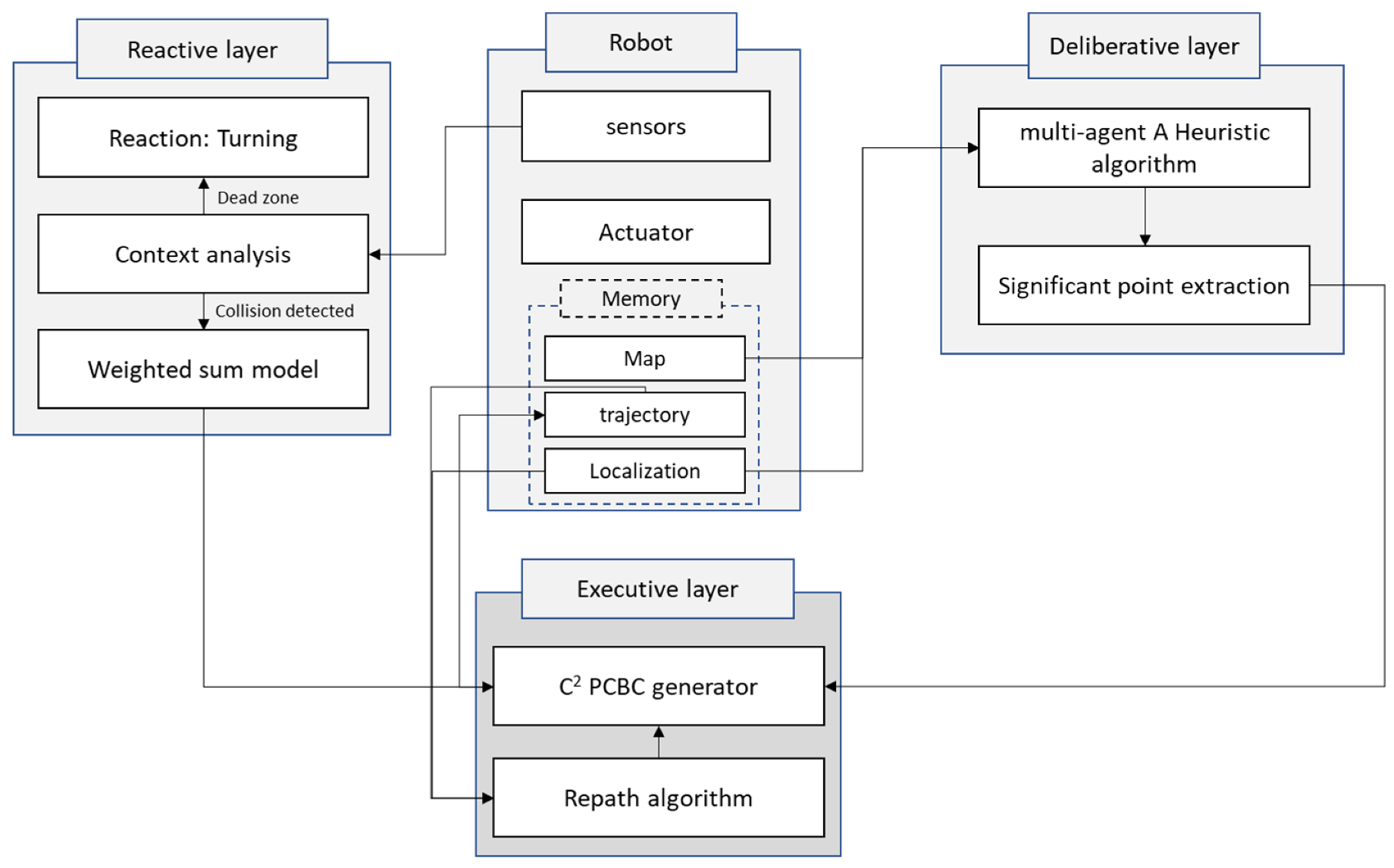

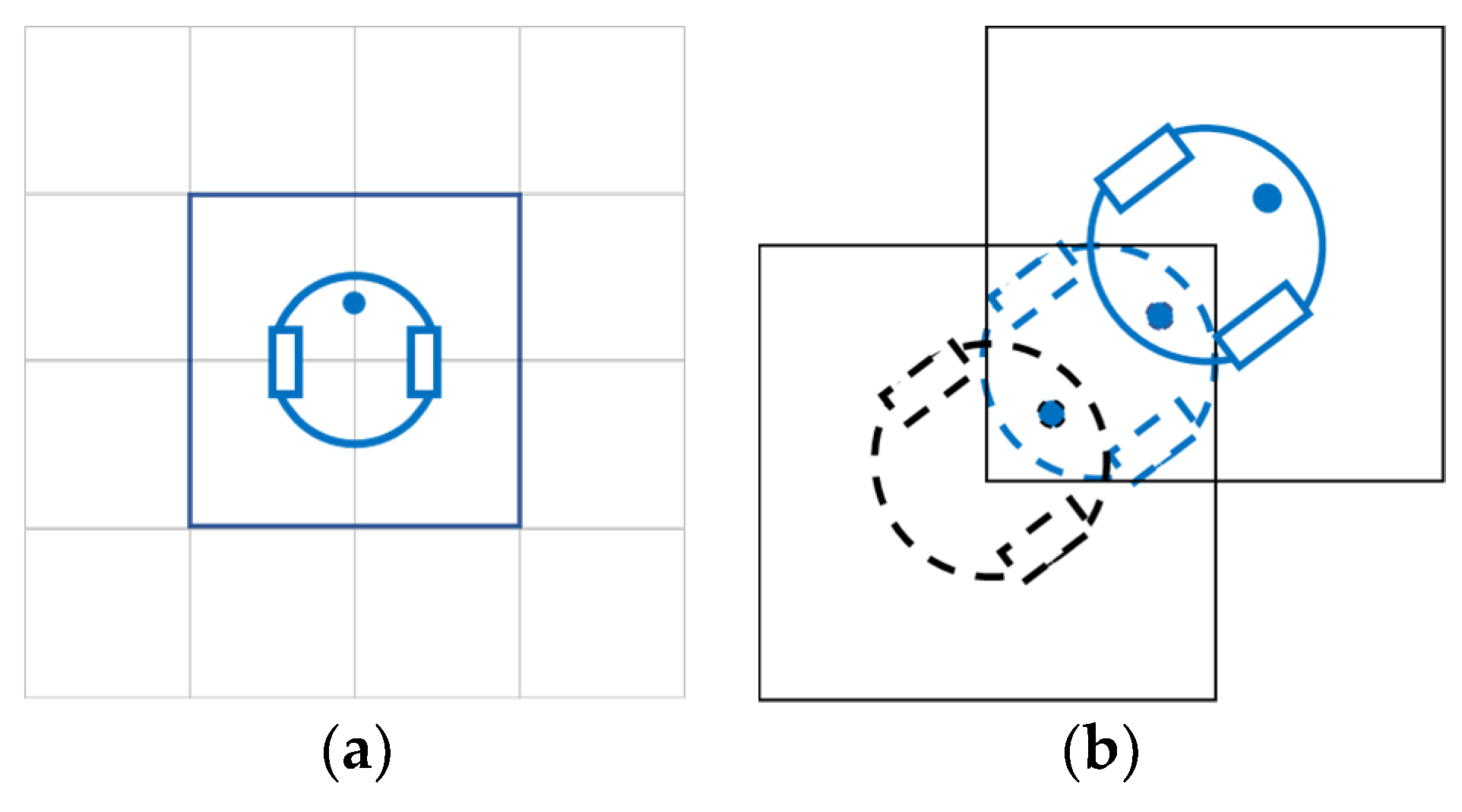



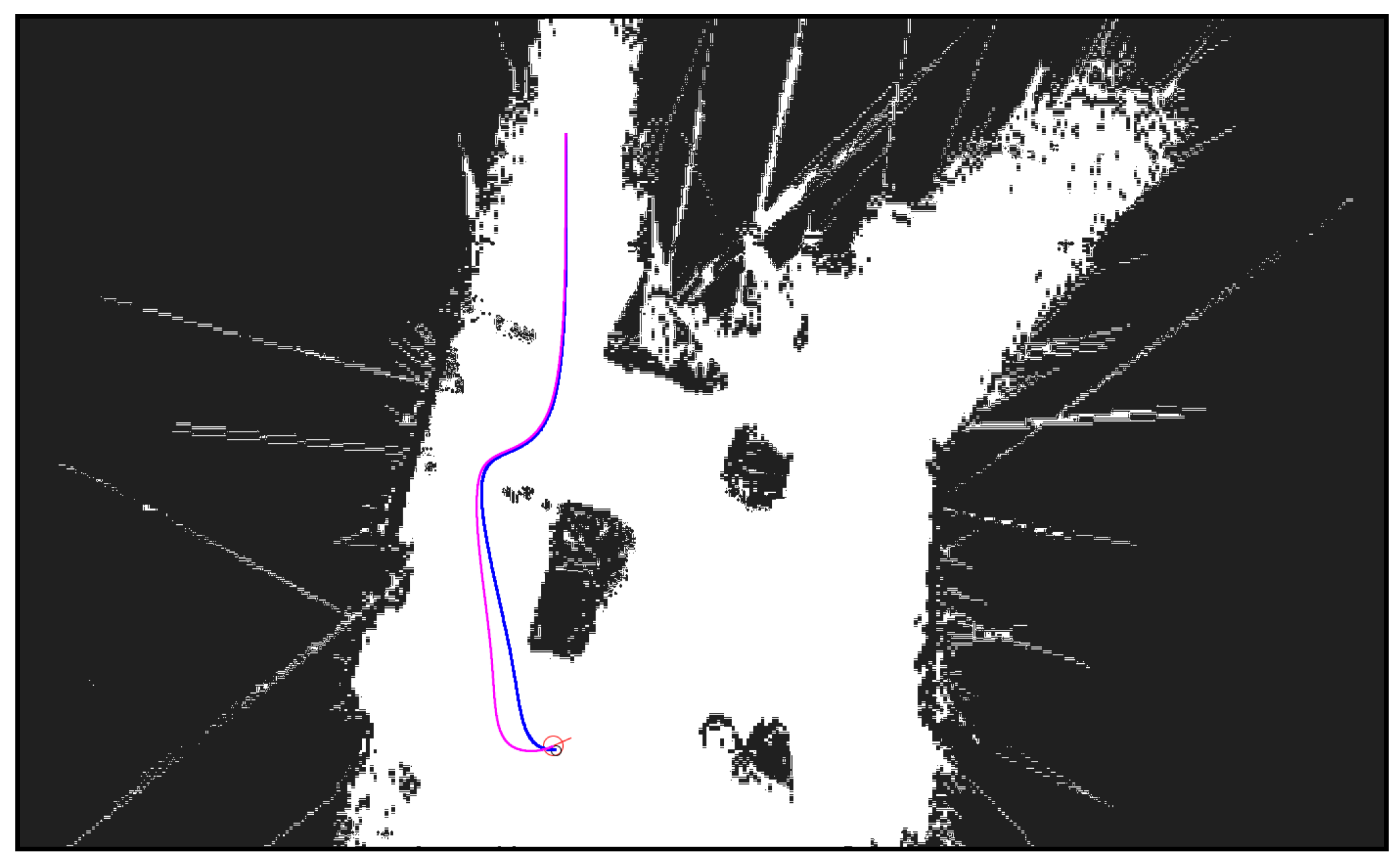
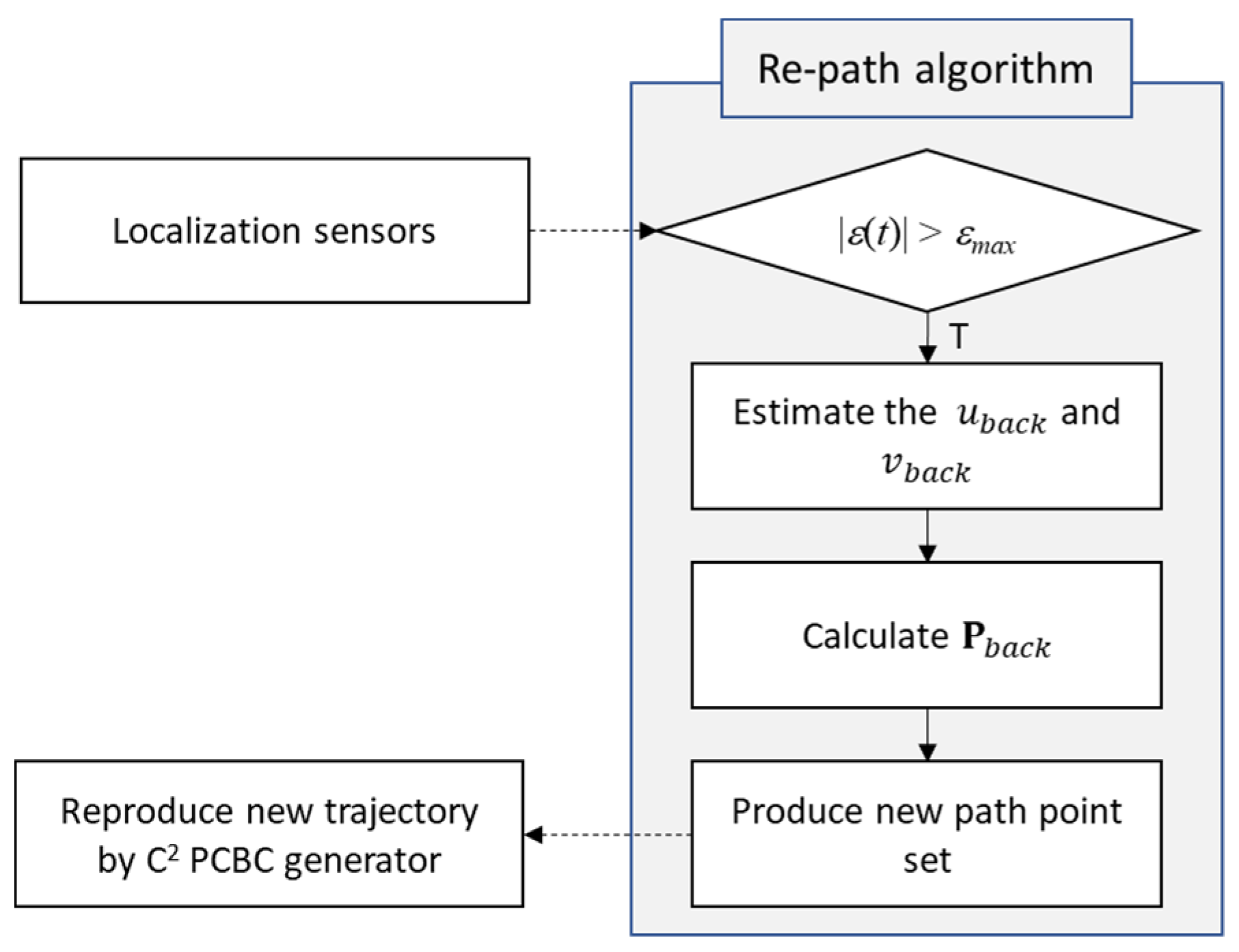


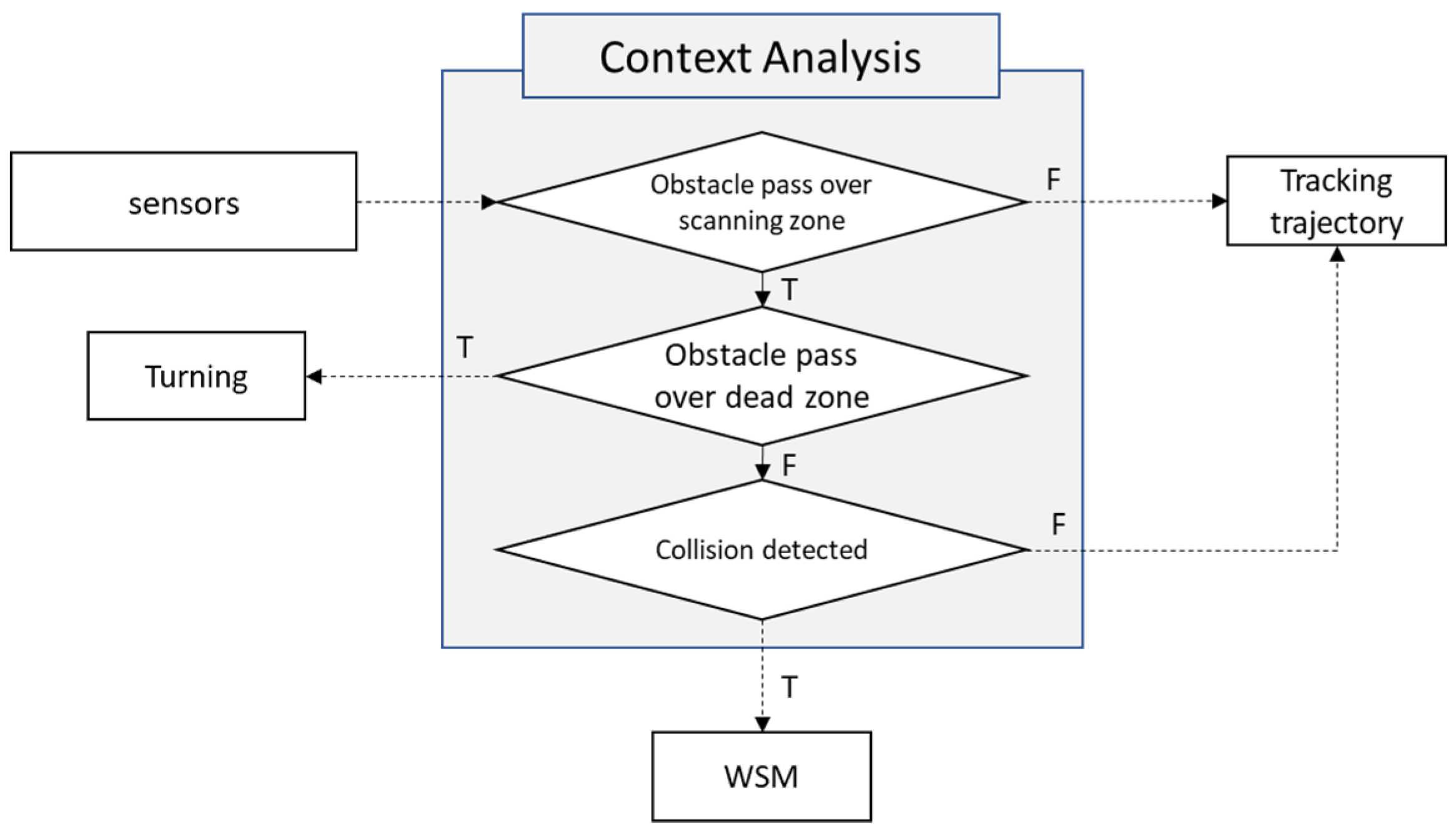
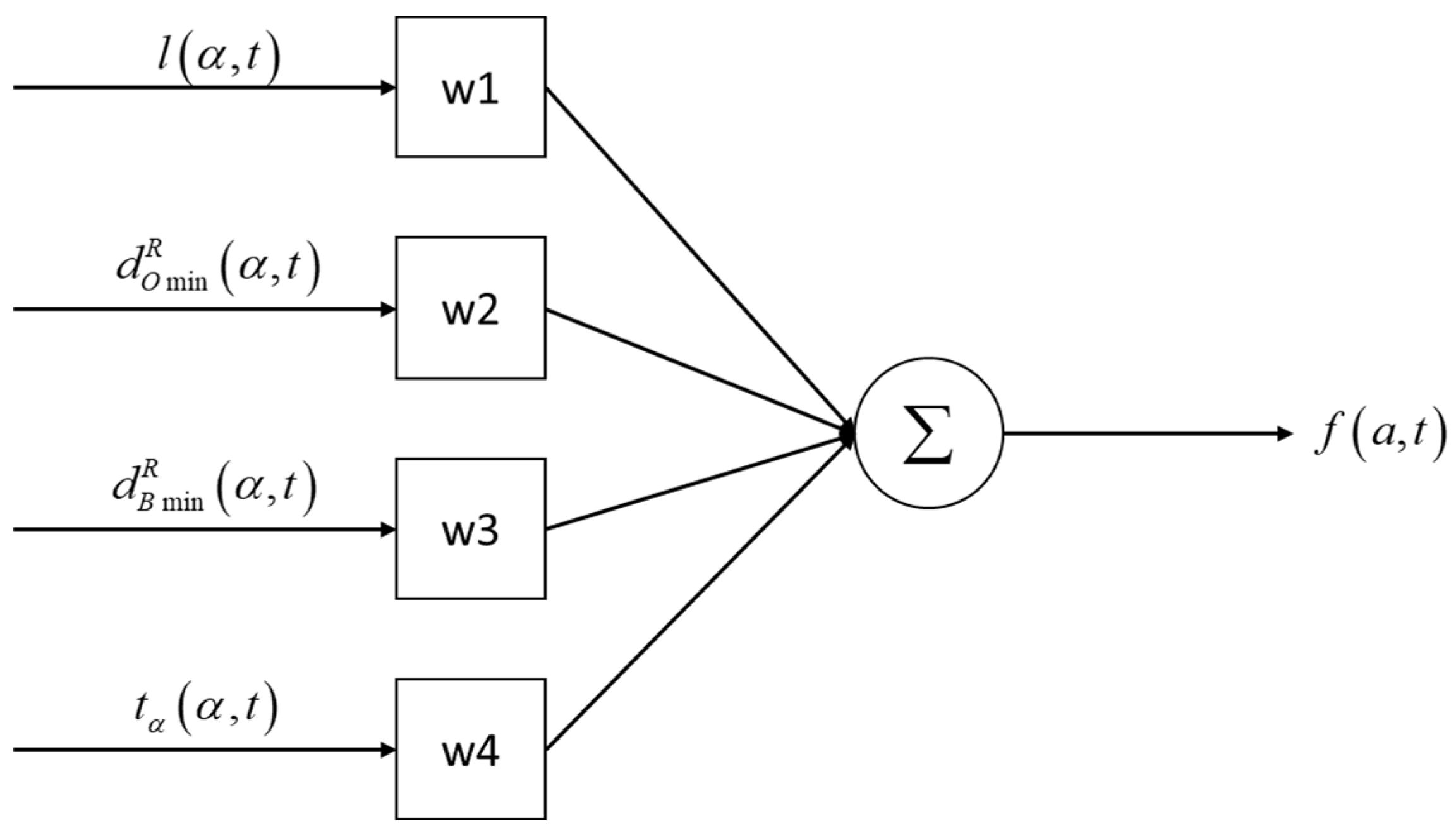
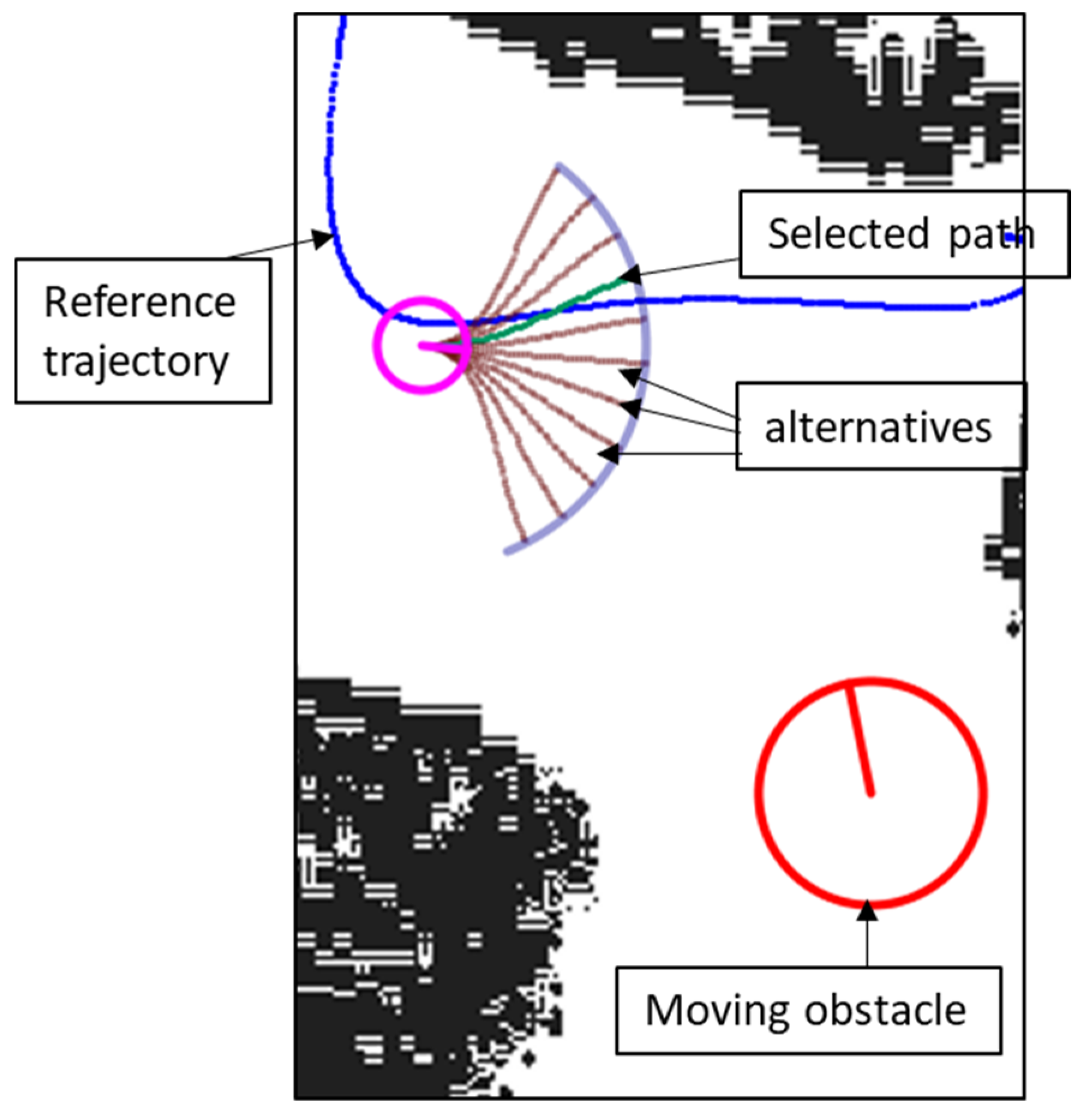

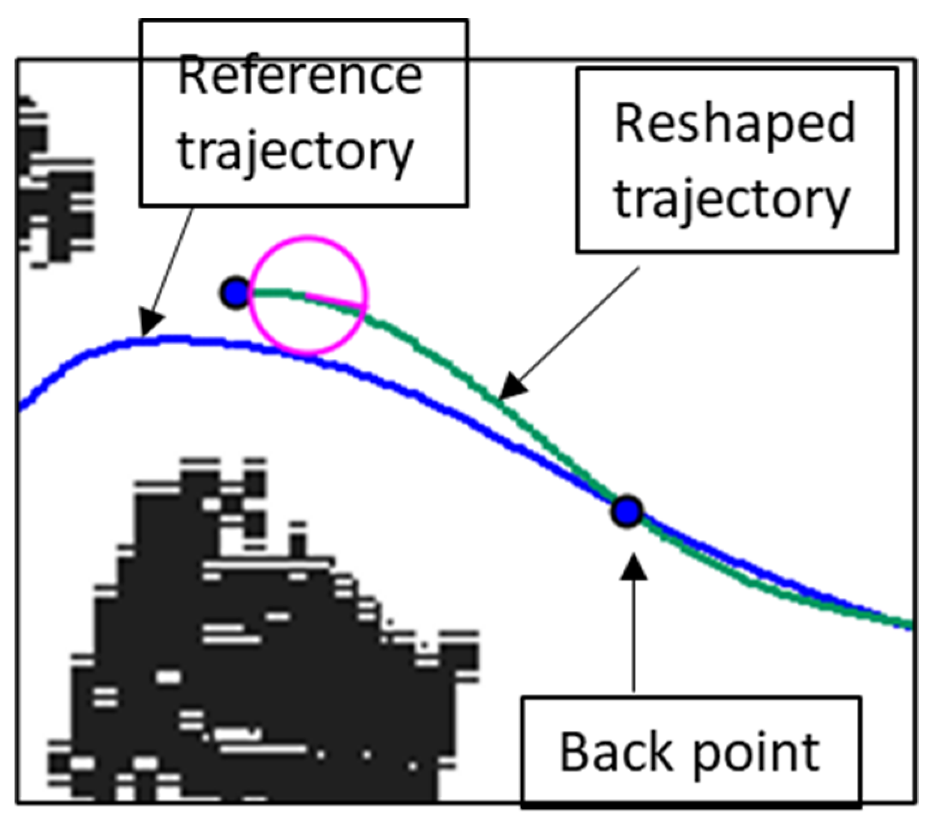

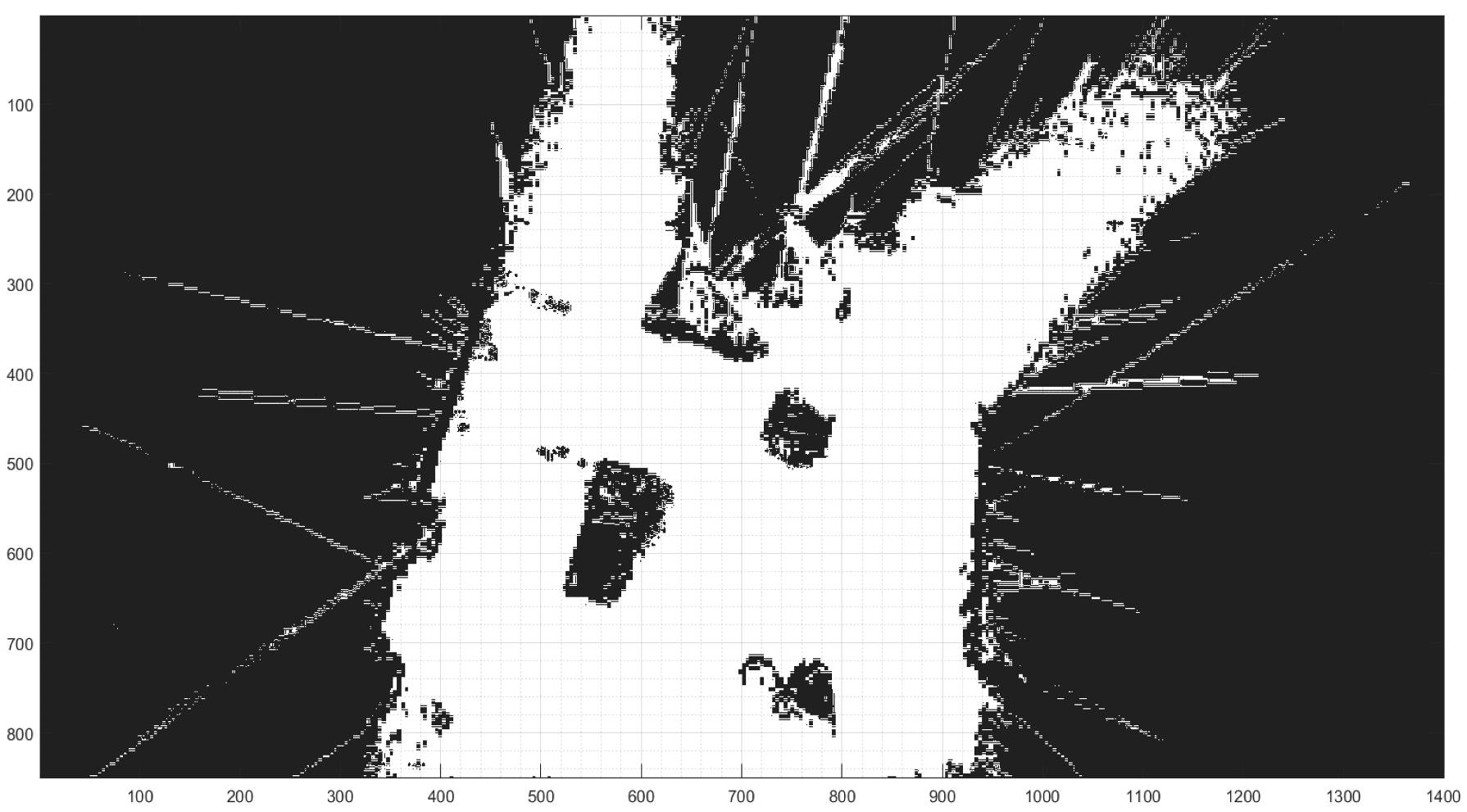
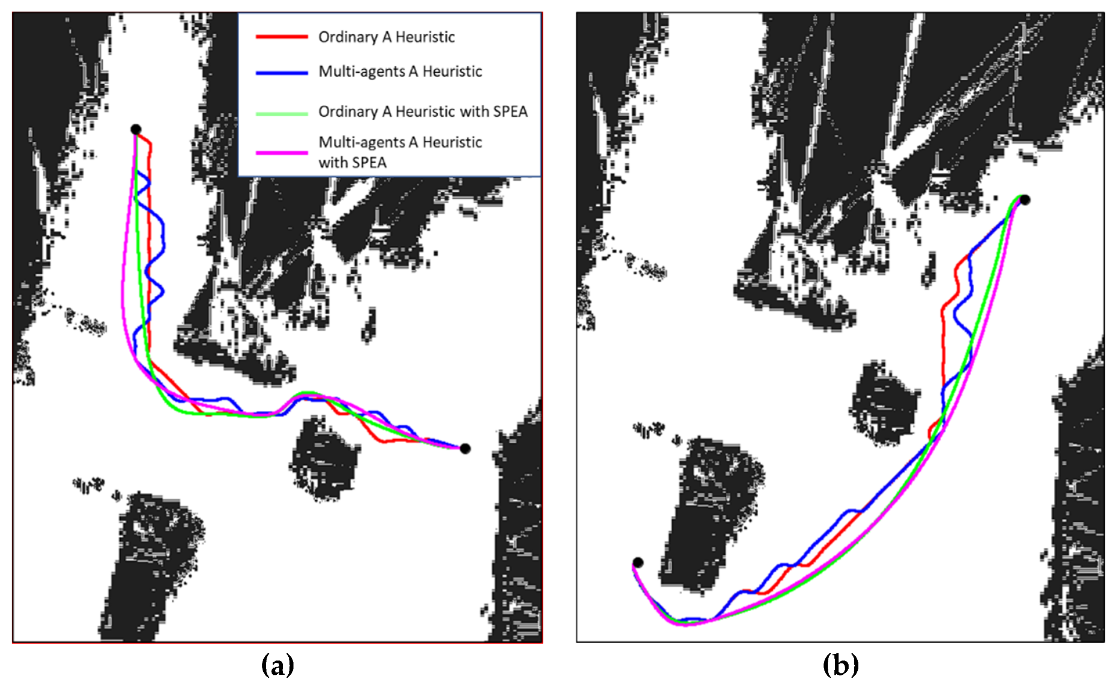

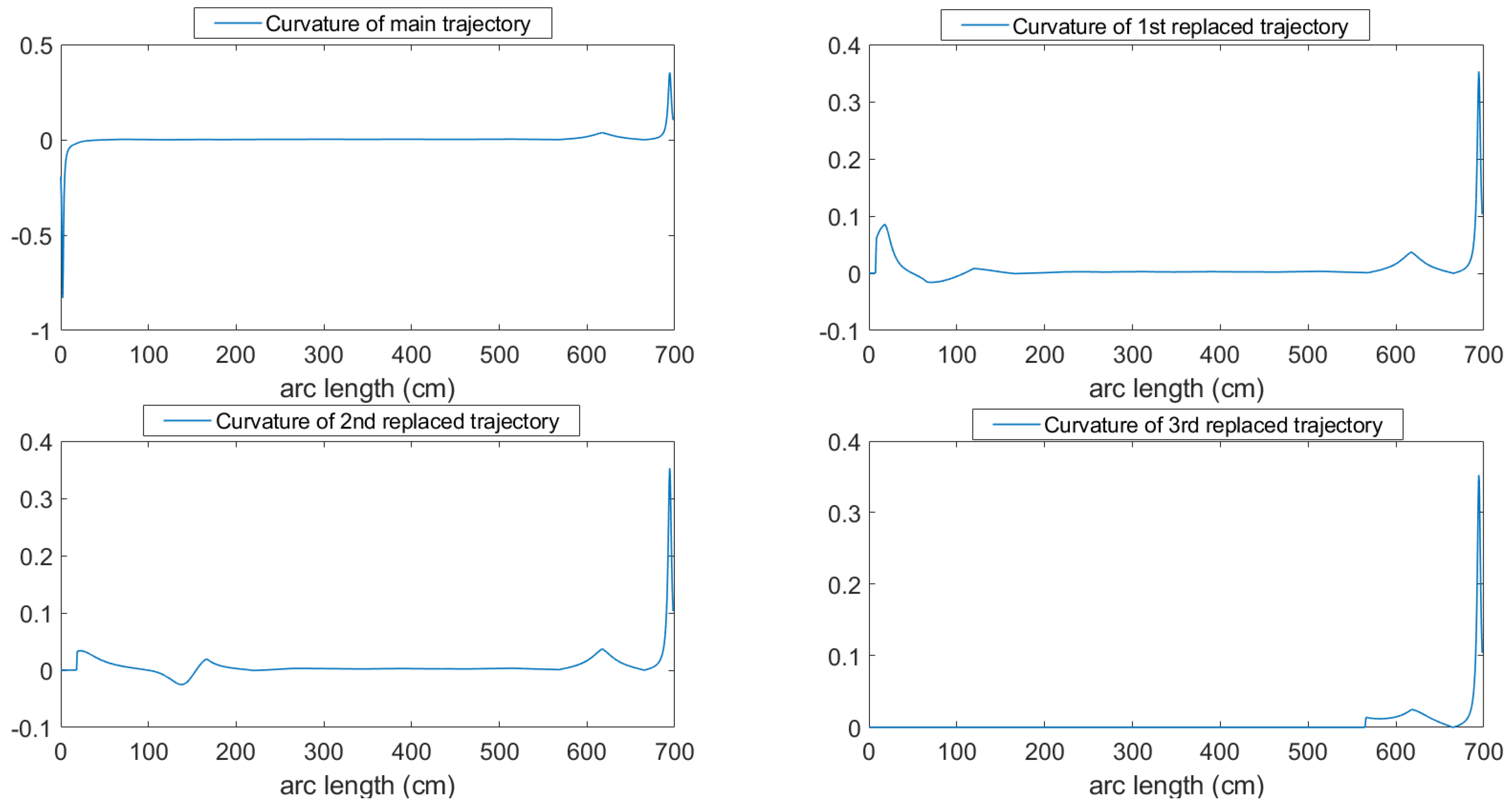
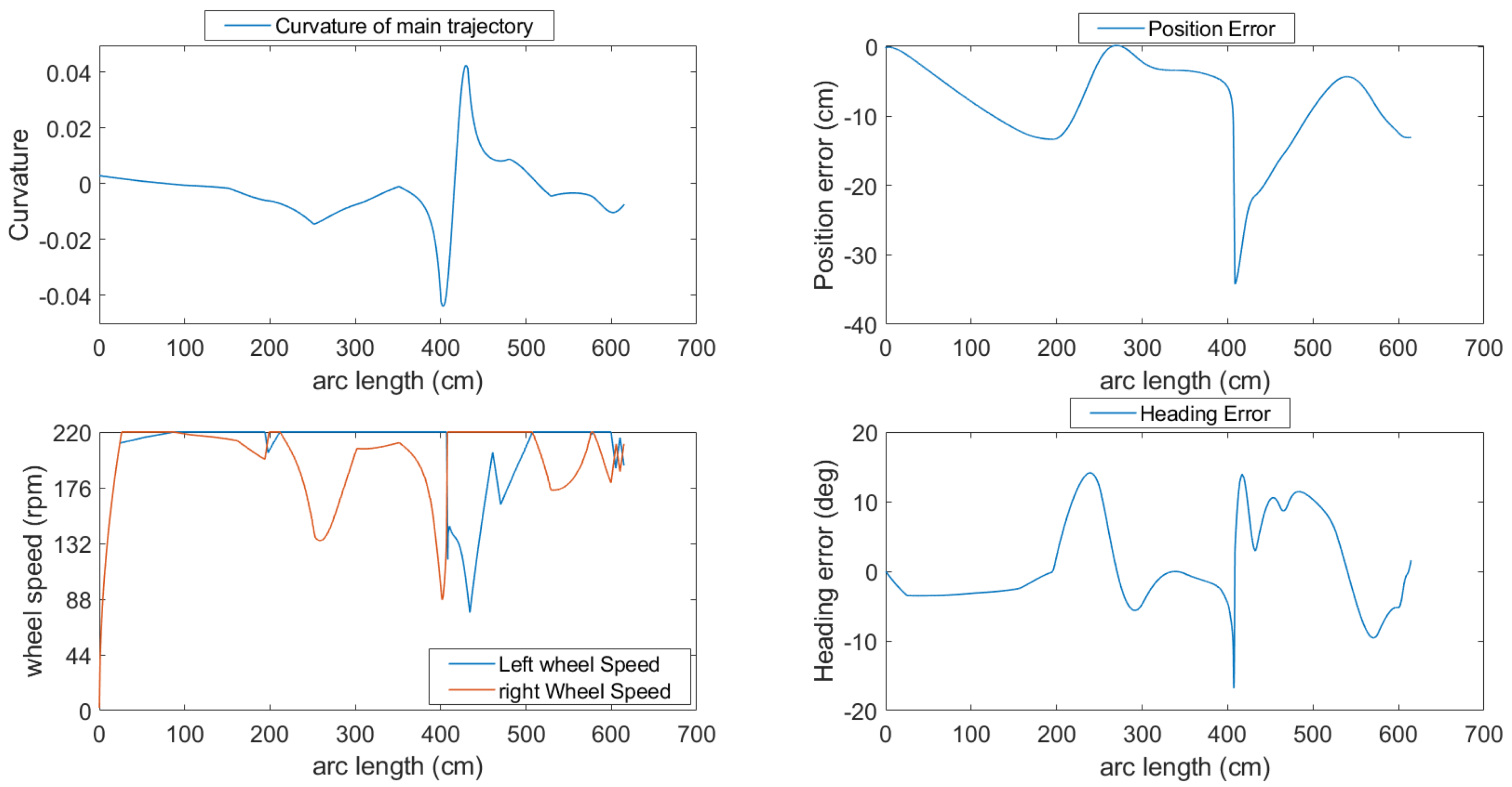

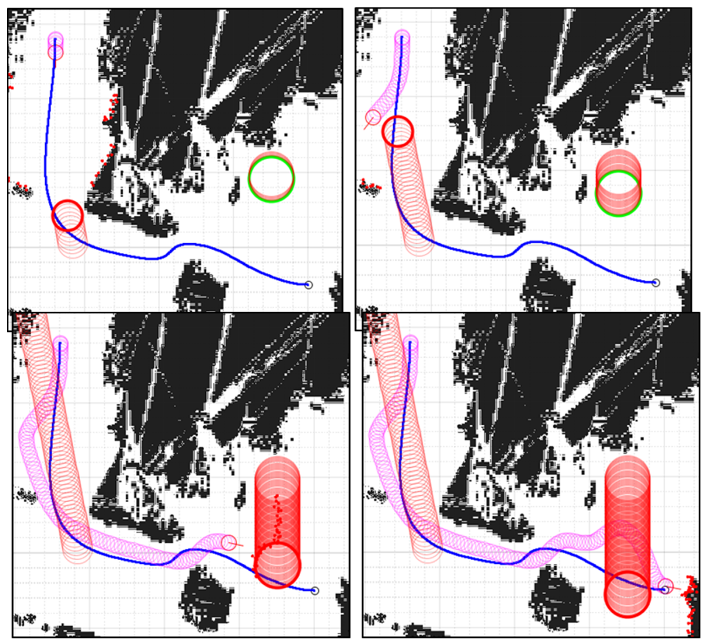
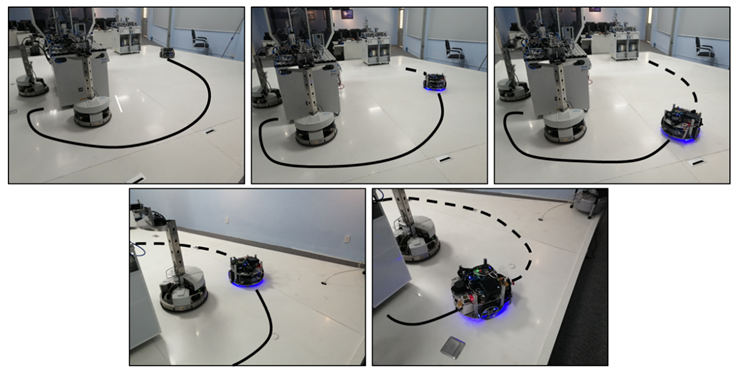
| v | u | l(u,v) | L(u,v) |
|---|---|---|---|
| 0 | 0 | 0 | 0 |
| 0 | 0.01 | 0.01 | 0.01 |
| 0 | 0.02 | 2.8427 | 2.8427 |
| 0 | 0.03 | 5.6792 | 5.6792 |
| 0 | 0.04 | 8.5367 | 8.5367 |
| 0 | 0.05 | 11.3858 | 11.3858 |
| . | . | . | . |
| . | . | . | . |
| 3 | 0 | 0 | 687.7763 |
| 3 | 0.01 | 0.001 | 687.7773 |
| 3 | 0.02 | 1.8897 | 689.6662 |
| 3 | 0.03 | 3.7465 | 691.5228 |
| . | . | . | . |
| . | . | . | . |
| 3 | 0.98 | 115.2653 | 803.0417 |
| 3 | 0.99 | 116.2936 | 804.07 |
| 3 | 1 | 117.343 | 805.1194 |
| Scenario # | Initial Position | Initial Heading | Destination Position | Destination Heading |
|---|---|---|---|---|
| 1 | (560, 120) | 90 degree | (900, 450) | 0 degree |
| 2 | (900, 250) | −90 degree | (500, 625) | 0 degree |
| Algorithm | Processing Time (ms) | Length of Path (cm) | Total Checked Spot (Spot) | Path Set Size (Spot) |
|---|---|---|---|---|
| Original A heuristics | 12 | 603.1909 | 251 | 39 |
| Multi-agent A heuristics | 5 | 657.7839 | 804 | 40 |
| Original A heuristics with significant points extraction algorithm | N/A | 601.83997 | N/A | 7 |
| Multi-agent A heuristics with significant points extraction algorithm | N/A | 602.94867 | N/A | 6 |
| Algorithm | Processing Time (ms) | Length of Path (cm) | Total Checked Spot (Spot) | Path Set Size (Spot) |
|---|---|---|---|---|
| Original A heuristics | 18 | 692.5779 | 618 | 40 |
| Multi-agent A heuristics | 16 | 704.1758 | 1416 | 40 |
| Original A heuristics with significant points extraction algorithm | N/A | 666.4103 | N/A | 5 |
| Multi-agent A heuristics with significant points extraction algorithm | N/A | 668.11456 | N/A | 5 |
| Parameter | Value |
|---|---|
| 0.4 m | |
| 0.36 m | |
| 0.06 m | |
| 220 rpm | |
| 2.2 rad/s2 |
| 1st Obstacle | 2nd Obstacle | |
|---|---|---|
| Initial position | (585, 400) | (850, 300) |
| Velocity | (−0.1, −0.5) | (0, 0.1) |
| Size (cm) | 40 | 60 |
© 2020 by the authors. Licensee MDPI, Basel, Switzerland. This article is an open access article distributed under the terms and conditions of the Creative Commons Attribution (CC BY) license (http://creativecommons.org/licenses/by/4.0/).
Share and Cite
Gia Luan, P.; Thinh, N.T. Real-Time Hybrid Navigation System-Based Path Planning and Obstacle Avoidance for Mobile Robots. Appl. Sci. 2020, 10, 3355. https://doi.org/10.3390/app10103355
Gia Luan P, Thinh NT. Real-Time Hybrid Navigation System-Based Path Planning and Obstacle Avoidance for Mobile Robots. Applied Sciences. 2020; 10(10):3355. https://doi.org/10.3390/app10103355
Chicago/Turabian StyleGia Luan, Phan, and Nguyen Truong Thinh. 2020. "Real-Time Hybrid Navigation System-Based Path Planning and Obstacle Avoidance for Mobile Robots" Applied Sciences 10, no. 10: 3355. https://doi.org/10.3390/app10103355
APA StyleGia Luan, P., & Thinh, N. T. (2020). Real-Time Hybrid Navigation System-Based Path Planning and Obstacle Avoidance for Mobile Robots. Applied Sciences, 10(10), 3355. https://doi.org/10.3390/app10103355






